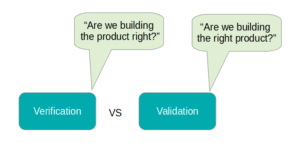Verification and validation is a process that identifies whether a software is developing as per the given requirements and specifications.
The basic difference between verification and validation testing is that, verification assures whether a product meets the specifications or not ,whereas, validation checks whether a product meets client’s requirement or not.
Difference between Validation and Verification Testing in Tabular form
| Verification Testing | Validation Testing |
|---|---|
| Main objective is to assure that product meets the designed specifications | Main objective is to assure that product meets the client’ requirements |
| This is done during the development phase | This done after the development phase |
| This is carried out by the Quality Assurance (QA) team | This is carried out by the Quality Checking (QC) team |
| It is static and proactive in nature | It is dynamic and reactive in nature |
| It does not involves testing of codes | It involves testing of code |
| It tests the software thoroughly without executing the code | It tests the software by executing the code with the goal of finding defects and improve performance |
| The main goal of this testing method is to find bugs, ensuring the quality level of product and avoid defects. | The main goal is to ensure the software work properly and meeting all the requirement and specification mentioned by the client |
| It supports techniques such as Inspection, walkthrough, Reviews and more | It supports white box testing and black box testing techniques such as unit testing, integration testing, system testing, and Acceptance testing |
Verification
“Are we building the product right?”
Definition: Verification is an approach of checking if the product that is being built is satisfying the imposed requirements and specifications, during the development phase.
Characteristics of Verification testing:
- Discovering errors in early stages
- Faster & Accurate
- Responsible for detecting bugs
Validation
“Are we building the right product?”
Definition: Validation is an approach of checking if the product, built, meets the needs and requirements of the client, after the end of the development phase.
You would also like :
Difference between static testing and dynamic testing




